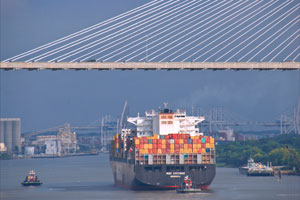Savannah Surges as Mighty Gate for Imports on US Growth

Blueberries from Chile, Peru and Brazil may soon be heading toward U.S. tables via Savannah, Georgia, opening another shipping market in the city’s emergence as a major trade hub.
With a population of just 143,000, Savannah trails only New York City as an East Coast container port and ranks No. 4 nationally after Los Angeles and Long Beach, California, according to Datamyne and compiled by Bloomberg.
“Not only have we been the fastest-growing port in the U.S. for a decade now,” Curtis Foltz, executive director of the Georgia Ports Authority, said at the organization’s annual meeting in September. “But we’re now in a position to grow and become No. 1. Something that was unfathomable a decade ago is something that is at least within our sight.”
The city best known for its haunted-house tours and moss-draped trees has been the fastest-growing major U.S. harbor for most of the last decade with an average annual growth rate of 11%.
Once a sleepy outpost for timber and white-clay exports, Savannah has leapfrogged Baltimore, Miami, Charleston, Norfolk and Philadelphia thanks to its transportation network and the economic expansion in the U.S. and southeast region.
“This is the fastest-growing demographic area in the country, and it will be the fastest-growing demographic area in the country for the next half century,” Foltz said. “We are the leading port serving the Southeast.”
The U.S economy has grown by an average of 2.2 % annually since the recession ended in 2009. By comparison, the gross domestic product of more than half the states that comprise the 13-state Southeast region have been growing at a faster rate, according to the U.S. Bureau of Economic Analysis.
The Port of Savannah’s September imports climbed 21.7% compared with a 7% increase for New York, although New York still imported almost twice the cargo — 256,244 twenty-foot equivalent units compared to 125,113 at Savannah. The busiest U.S. port, Los Angeles, grew 9.6% last month and imports into Long Beach, the second-busiest, rose 4.3%.
Few expect Savannah’s port to overtake New York anytime soon.
“It has been widely accepted and time-tested that ships will always move large cargo volumes through New York because of its massive consuming population,” Stan Payne, the former head of the Canaveral Port Authority in Florida and now a shipping consultant, said in an e-mail. “In the end, if Savannah does overtake New York and New Jersey, and it certainly is within the realm of reasonable possibility, then it will do so because of focus and a political and operating structure that provides it the control to turn that focus into results.”
A sister port in Brunswick, Georgia, about 70 miles south, handles mainly roll-on, roll-off traffic, including automobile exports. Brunswick also imports more Jaguars, Mercedes and Porsches than any port in the U.S. Together, the two ports contributed $32.4 billion to Georgia’s economy in 2011, or 7.8% of the total, according to the most recent University of Georgia study. They were responsible for 352,146 jobs, including 37,000 in Savannah’s home Chatham County.
One selling point against competitors in other cities is the Savannah port’s proximity to major expressways such as Interstate 20 and Interstate 95.
“It attracts a lot of traffic that way,” said Lee Klaskow, senior analyst at Bloomberg Intelligence in Skillman, N.J “They can get folks from a boat to a train or a highway quickly.”
Truckers can do nine “turns” a day, meaning picking or dropping off freight, said Page Siplon, executive director of the Georgia Centers of Innovation, which is part of the state’s economic development department. That compares to an average of 1.5 per day at the three other top U.S. ports.
Savannah’s port isn’t as deep as the West Coast ports, or even as deep as some on the East Coast, such as Norfolk. Savannah is one of several East Coast ports working to deepen their waters in order to attract the larger ships that will one day come through the expanded Panama Canal.
Savannah’s path to a world-class port began almost 20 years ago, when Savannah Economic Development Authority built a speculative distribution warehouse complex, initially with no tenants. The distribution network around the port now includes warehouses for retailers such as Target Corp. (TGT), Home Depot Inc. (HD), Family Dollar Stores Inc. (FDO), as well as cold storage for chickens, of which Georgia is the world’s biggest exporter.
While Western ports still hold the dominant market share, with 54.9% of volume in 2013, that’s down from 60.8% six years earlier. Much of the East Coast’s gain can be traced to vessels from Asia increasingly relying on the Suez Canal, according to JLL Research, a Chicago-based commercial real estate and investment services provider.
Savannah’s effort to grow further by importing formerly New York-bound fruit is still in the pilot stage.
That effort began in September, in cooperation with the U.S. Department of Agriculture. Fruit that once had to unload in cooler climates, in order to control pests, will now be chilled during the trip across the sea, which accomplishes the same purpose.
Port officials are talking to growers to convince them to make the switch. According to a January 2014 Congressional Research Service report, the U.S. imported more than $18 billion in fruits and vegetables in 2011. It imported $6.2 billion of fresh, dried or frozen fruit, up from $2.6 billion in 2000. Chile, Peru and Brazil fruit and vegetable exports to the U.S. were $1.7 billion, $706 million, and $398 million respectively.
“It’s going to be a game changer,” said Siplon.

